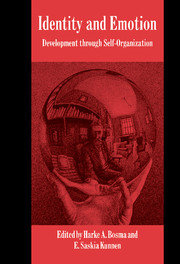Book contents
- Frontmatter
- Contents
- List of contributors
- Preface
- 1 Introduction
- 2 Developments in self-concept theory and research: affect, context, and variability
- Commentary: the self-concept is dead, long live … which construct or process? Differentiation and organization of self-related theories
- 3 The self and emotions
- Commentary: the self and emotions
- 4 Fish, foxes, and talking in the classroom: introducing dynamic systems concepts and approaches
- Commentary: fish, foxes, identity, and emotion
- 5 A relational perspective on the development of self and emotion
- Commentary: the personal experience of coherence
- 6 Affective processes in a multivoiced self
- Commentary: affective processes in a multivoiced self in action
- 7 Old–new answers and new-old questions for personality and emotion: a matter of complexity
- Commentary: emotions as sources of information about the self
- 8 Cognitive–emotional self-organization in personality development and personal identity
- Commentary: two faces of identity
- 9 A self-organizational approach to identity and emotions: an overview and implications
- References
- Author index
- Subject index
- Titles in the series
6 - Affective processes in a multivoiced self
Published online by Cambridge University Press: 28 October 2009
- Frontmatter
- Contents
- List of contributors
- Preface
- 1 Introduction
- 2 Developments in self-concept theory and research: affect, context, and variability
- Commentary: the self-concept is dead, long live … which construct or process? Differentiation and organization of self-related theories
- 3 The self and emotions
- Commentary: the self and emotions
- 4 Fish, foxes, and talking in the classroom: introducing dynamic systems concepts and approaches
- Commentary: fish, foxes, identity, and emotion
- 5 A relational perspective on the development of self and emotion
- Commentary: the personal experience of coherence
- 6 Affective processes in a multivoiced self
- Commentary: affective processes in a multivoiced self in action
- 7 Old–new answers and new-old questions for personality and emotion: a matter of complexity
- Commentary: emotions as sources of information about the self
- 8 Cognitive–emotional self-organization in personality development and personal identity
- Commentary: two faces of identity
- 9 A self-organizational approach to identity and emotions: an overview and implications
- References
- Author index
- Subject index
- Titles in the series
Summary
In studying affective processes, one can start from the assumption that during human development, affective responses are increasingly influenced by the relation individuals have with themselves. To illustrate this, let's look at a crawling infant's fascination for a bouncing ball. Initially, the ball is not experienced as part of the infant's self, but the influence of self-reflectivity becomes explicit when the child is approximately two years old. When playing with another child, it may shout: “Ball mine!” The child has developed a special relationship with the ball, considering himself its “possessor.” The ball falls within an invisible boundary between Mine and not-Mine. The child's definition of himself as the possessor not only indicates that the self is explicitly involved, it also has immediate repercussions for the affective processes both between the child and the ball and between the child and others. Still later, when the child has become a member of a sports club, he may consider himself a “good soccer player” and feel very proud of this. This self-evaluation indicates that the child, being able to adopt the complex language-games of a community, applies to himself a particular standard which is, as an organizing principle, accepted by a group or community. In Mead's (1934) terms, the child is organizing his self by “taking the role of the other” and his feelings are also organized by this role-taking.
As the above examples suggest, the existence of primary affect (e.g. joy in playing with a ball) is influenced by the development of the self (“ball is mine”), which strongly colors and organizes the child's, and later the adult's, secondary affective responses to a great variety of situations.
- Type
- Chapter
- Information
- Identity and EmotionDevelopment through Self-Organization, pp. 120 - 140Publisher: Cambridge University PressPrint publication year: 2001
- 12
- Cited by

